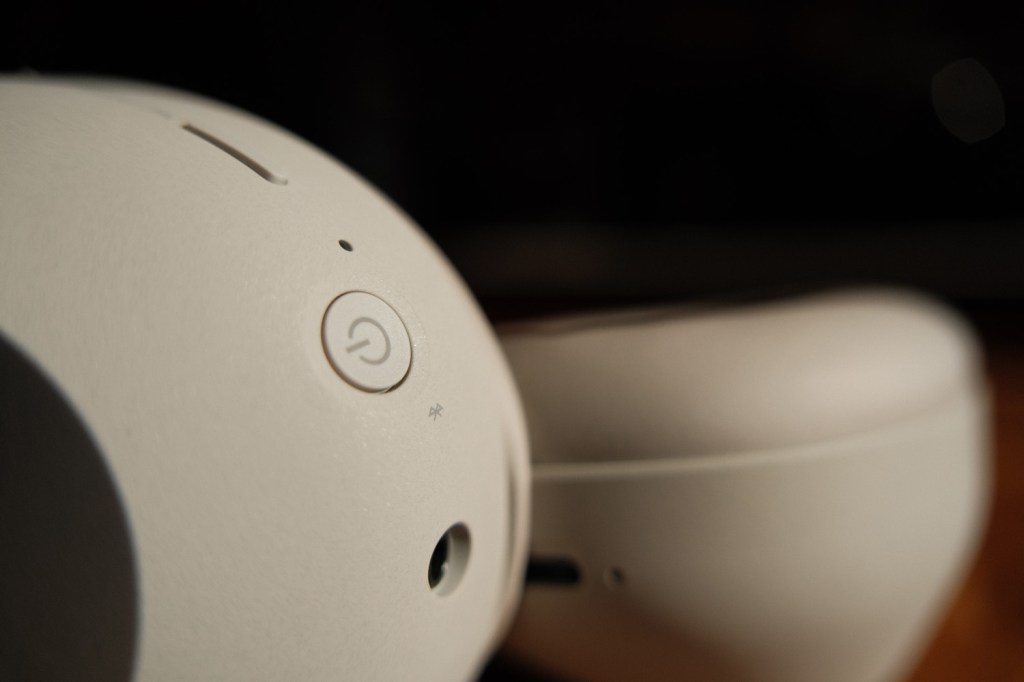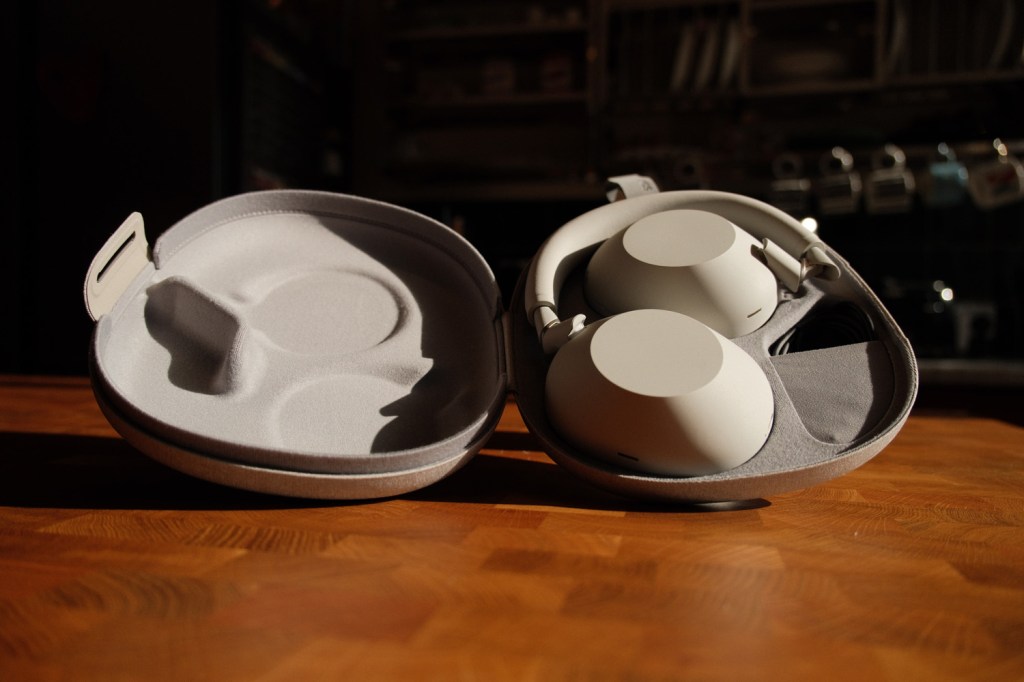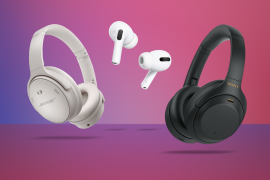I was one of the first to review the Sony WH-1000XM6 and they’re the new gold standard for noise-canceling headphones
Sony's legendary flagship headphones get a welcome redesign with foldable hinges and even more impressive noise-cancelling prowess

Stuff Verdict
Sony’s legendary noise-cancelling headphones get even better, with the return of foldability, superb sound, and jaw-dropping ANC performance.
Pros
- Return of folding design improves portability
- Incredible noise cancellation
- Exceptional sound quality across all music genres
- Intuitive touch controls and improved button design
- App rammed with features and customisation options
Cons
- Premium price
- Light-coloured model could more easily show wear over time
- Feature-rich app may be overwhelming for casual users
Introduction
I’m a simple man. Whenever someone asks me what new headphones they should get, I confidently point them in the direction of the five-star WH-1000XM5. Their exceptional audio and world-blocking noise cancellation propelled them to the top Stuff’s list of the best headphones, after all. But when you’re already sitting comfortably at the apex of the noise-cancelling headphone hierarchy, how do you push things further?
Sony’s answer comes in the form of the WH-1000XM6 – the latest evolution of its flagship over-ears that have dominated the premium audio landscape for years.
Available now for $450/£400/€450, these aren’t just minor tweaks to a winning formula, but rather thoughtful refinements of what made the XM5 so exceptional, with some welcome returning features and genuinely impressive performance upgrades thrown in.
In a world where the best headphones command high prices though, Sony’s latest flagship needs to deliver something special to justify that premium price tag – and after spending time with them, I’m pleased to report that they’ve done exactly that.
Comparisons and value: plenty of rivals



At £400, the WH-1000XM6 find themselves in a fiercely competitive premium headphone market, one that also includes the recently-introduced and excellent Bowers & Wilkins PX7 S3.
Their most obvious rival is Bose’s QuietComfort Ultra, which typically retail for around $399/£450/, though at the time of writing, they’re available on offer for a more palatable $100/£100 off.
These Bose rivals offer up to 24 hours of battery life (about six hours short of the Sony) along with the company’s highly lauded ANC capabilities. Meanwhile, Apple’s AirPods Max still command a hefty $549/£499, integrating seamlessly with Apple’s ecosystem.
The most interesting aspect of the XM6’s positioning, is how Sony has evolved the product line. The XM5 was a departure from the XM4, losing the folding design that made earlier models so travel-friendly. With the XM6, Sony has listened to user feedback, bringing back foldability while further improving sound quality and ANC performance.
At £400, it’s £20 more than the XM5’s launch price, but given the improvements and the general upward trend in premium headphone pricing, it remains a competitive option for those seeking the absolute best in portable audio – not to mention Sony’s claim of the best noise cancelling on the market.
For those not ready to spend so much, the XM5 remains an excellent option and will likely see discounts as the XM6 hits stores. Similarly, Sennheiser’s Momentum 4 are decent value at around $380/£300/ though without quite matching Sony’s noise-cancelling prowess.
With the scene set, let’s see if the XM6 live up to the long-awaited hype.
Design: fold yourself into even more comfort




In its design team’s own words, the XM6’s design is “evolutionary, not revolutionary.” That’s no bad thing, mind, given that the XM5 are already a sleek pair of headphones. Having said that, there are some refinements and improvements here worth noting.
The biggest design change is the return of the ability to fold – a feature that was dropped from the XM5, much to the chagrin of fans. The new twisting hinge mechanism feels reassuringly solid too, with a stainless steel/plastic construction. Once folded, the XM6 become flat, and don’t take up much room, even in the included carry case.
The case, by the way, has ditched the zip for a more accessible and easy-opening magnetic flap mechanism – a move courtesy of Sony’s Inclusive Design Workshop. Combined with the built-in nook for storing the USB-C and 3.5mm audio cable, it’s a neat, nimble setup that’s well-suited to travelling – once you get the knack of folding it in the specific orientation the case demands, at least. A few days in, and contorting the XM6 in just the right way to fit it in the case is still a toss up between managing it first time, or playing a game of unintentional Rubik’s Cube where I’m desperately folding and twisting both earcups for numerous minutes until the lid snaps shut. I suppose I need more practice.
Other design tweaks on the headphones include an asymmetrical headband (it bulges out slightly at the back), to help you easily know which way around they should be worn. Sony’s designers told us that with the previous symmetrical headband, some users accidentally wore them the wrong way round, spoiling the optimal seal for the best audio and sound quality.
They’ve also reduced the ‘Mickey Mouse ears’ effect by tapering the sides in slightly, so that there’s less of a pronounced gap between your head and the band – something that’s very welcomed by a follicly challenged person like myself, where such headphone gaps are often too prominent.
As for the materials, the synthetic leather earcups and headband material feel plush and pleasantly soft, though I wonder how well my Silver review unit will hold up with its light grey finish. I can’t imagine it’ll be long before it looks a bit grubby – and I say that as someone who absolutely looks after my tech. Black or Midnight Blue are probably better choices if want a better chance of keeping a pristine look for longer, but that’s not to say I dislike the Silver model. Its matte grey finish, as unintrusive as it is, actually stands out from the crowd in its own, minimalistic way.
The earcups, incidentally, house four external mics each, all of which have a new mesh cover that helps reduce wind noise during calls.
One last design tweak is the power button, which is now no longer identical in size and shape to the ANC button, as was the case on the XM5. A welcome design change, for obvious reasons.
On the subject of controls, the touch-sensitive right earcup is easy and intuitive to use. Double-tap to play/pause music. A long tap calls up either Sony or Google’s assistant. Swiping forwards or backwards lets you choose the next track or go back, and swiping up and down changes the volume. Pro tip: swipe up or down, hold your finger in place, and the volume will continue to rise or lower accordingly, saving you from multiple mini swipes.
As for comfort, my scales tip the headphones in at 252g, which puts them on par with their 253g Bose QuietComfort Ultra rivals. This light weight, combined with the plush earcups, make for a comfortable listening experience for long sessions.
Having said that, my ears still get hot and a little achey after a few hours, but I’ve yet to meet a single pair of over-ears that don’t have this affect on me. Let the record show, however, that the XM6 is one of the most comfortable pairs I’ve tested. And, not that I’d want to ruin their pristine finish with gym-induced sweat, but their slightly increased clamping force over the XM5 makes me feel confident that I could chuck some weights around and hit the elliptical machine without fear of the XM6 slipping off. The secure fit, incidentally, also makes for a great seal against the ears, which brings us smoothly on to…
Sound quality: incredible audio quality


The XM5 were one of the best-sounding headphones to have graced Stuff’s review gauntlet, paired with some of the best noise-cancelling skills to boot. And yet, it seems that Sony has managed to surpass the very lofty bar they set themselves – the XM6 not only sound incredible, but I predict that their noise-cancelling abilities will be widely regarded to be one of the best, if not, the best around. More on that later.
Let’s kick off with the sound first. Sony’s engineering team worked closely with professional audio engineers to tweak and equalise a new setup in the XM6. The new 30mm driver structure now has a rigid carbon fibre dome for crisper highs, while its soft edges reduce low-frequency noise. Combined with all manner of tweaking and general obsessive fiddling on their end, I can report that every eclectic track I threw at Sony’s headset was delivered to my ears with delectable clarity and immersion.
Danny Carey’s incredible, relentless command over his drum kit in Tool’s “Pneuma” is a borderline transcendent experience through the XM6, with each precise snare and rattling polyrhythmic high-hat hit delivered with mathematical precision. Meanwhile, the grounding, domineering bass notes anchor the whole thing throughout, remaining prominent, but not overbearing. Keenan’s haunting vocals are spacious and suitably impactful, while the raw energy of the lead guitar blasts out with raw, unapologetic fuzziness. And I’m not even a Tool superfan.
Less technical, but still an incredibly fun listen, is Voyager’s “Promise,” which, along with Electric Callboy’s “Pump It” and “Hypa Hypa,” showcase the XM6’s versatility. Many a pair of headphones have failed to blend together these bands’ cocktail of funky pop and metalcore, but the XM6 serve up a delightfully balanced charcuterie board of crisp vocals, thumping double-bass pedals, and testosterone-fueled screaming with ease.
Just as important, though, is their ability to step back and let the beauty of simplicity shine through. Agnes Obel’s “Riverside” presents an incredibly spacious, open experience, with vocals that envelop you on all sides, carried on the back of delicately presented piano keys. Elsewhere, from rib-shaking Goa trance, to funky Hip-Hop, or classic UK garage, the XM6 delivers on all counts.
I should also note that I listened to my test tracks both with the default setup, followed by a custom EQ that was created for me based on a series of choices I made in the Find Your Equaliser feature in Sony’s Sound Connect app.
The feature presents you with a series of different choices that affect the music you’re listening to. You tell it your favourites a few times, and boom – you’ve got a custom EQ based on your response. Since trying it out, I’ve left it on, as I prefer the slightly boosted bass and treble, though purists might prefer a cleaner setup. For them, there’s also a 10-band EQ to fiddle around with, making for a very personal, versatile experience.
Overall, these are some of the best-sounding headphones you can currently buy. Could you spend quite a bit more and push the envelope further though? Sure. You can always spend more money on a bigger fish. The headphones that have blown me away more than any other in terms of pure, spacious, accurate sound, are the Dali IO-12. And yes, they sound better than the Sony. But they also launched at £999, and even now, will still set you back £850. What the XM6 offer is still superb, stellar sound, for around the maximum most people (bar discerning, deep-pocketed audiophiles) will be willing to pay. And Dali’s offering can’t hold a candle to the XM6 in the noise cancelling department either. On that note…
Noise cancelling and call quality: simply exceptional

The noise-cancelling skills on offer here are exceptional, and it’s very much by design.
While the XM5 had eight microphones, the XM6 now has 12 – four on the outside and two on the inside of each earcup. Combined with Sony’s new QN3 noise-cancelling processor (which is now seven times faster), this setup, powered by a new AI algorithm, blocks out the outside world to an incredible extent – all while avoiding the often disorientating ‘ANC vacuum’ feeling that some rivals suffer from.
While I wasn’t allowed to test the XM6 on the flight back from Sony’s pre-embargo Madrid reviewer’s event (lest some eagle-eyed headphone fanatic spotted them and leaked them to the world), I did manage to sneak them into a plane toilet on a recent holiday flight to see how they fared against the incessant engine drone. The result? With ANC on, the plane’s engines ceased to exist. Metaphorically speaking, thankfully.
I’ve also put the XM6 through a very tough gauntlet in my home office setup – I share a space with my perpetually Zoom-imprisoned partner, while I walk at a treadmill desk with a fan-blaring gaming PC on top. Needless to say, it’s a very noisy work environment. Sometimes my cat jumps on the keyboard too, though that’s an unrelated problem.
Feline interference aside, with ANC on, the incessant thumping of the treadmill is barely audible, the PC fans cease to exist in my new reality, and the Zoom calls are reduced to the faint chattering of distant mice. And that’s with no music playing. Pop on a song, and I’m on my own planet. Bliss.
The ambient mode (or transparency, if you prefer), is seriously impressive as well. Combined with the lightness of the headphones, it feels like I’m not wearing anything at all, such is the clarity and realism of the outside world, beamed into my ears by all those external mics.
Another feature I’ve grown to love, is instantly being able to activate ambient mode when holding my palm over the right earcup. This lets me hear the outside world for as long as my hand is there, and has become one of my most-used features.
Sony’s Speak to chat function also returns, which, when turned on in the Sound Connect app, automatically turns ambient mode on when you start talking. In the XM5, there was a delay in this feature, which our reviewer, Dan Grabham, found long enough to end up taking the headphones off, negating the feature completely. That snappier processor in the XM6 seems to have done the trick though, because the ambient mode kicks in immediately when speaking, with no delays.
Naturally, I tried to trick this feature to test its limits by clapping loudly or tapping on the earcups to see if the headphones would recognise any loud noise as speech, but they weren’t fooled once. Touché.
As for call quality, three of the four external mics use beamforming tech to hone in on your mouth when you’re speaking during phone calls, while an algorithm cleverly scrubs out any distracting background noise. I tested this myself while speaking via the headset right next to my noisy PC, and the quality remained clean with no background noise. It still couldn’t eliminate the clacks of my keyboard, though, but for general background noise, the call quality is solid from the tests I’ve done so far.
One thing I will note, is that you shouldn’t expect the same audio recording quality if you’re pairing the XM6 to your PC. That’s not on them though – we can blame subpar PC Bluetooth hardware and shoddy Windows audio codecs for that. If Sony threw in a wireless USB dongle (some manufacturers like AKG are starting to do this with over-ears), then it truly could be the complete package, letting me ditch my dedicated PC mic for hassle-free Friday night Discord catch-ups. Maybe next time.
Other features: super app tweaks and spatial sound



I’ve covered some of the extra features in previous sections, but there are plenty more to be found. There’s Bluetooth Multipoint, for a start, letting you connect up to two devices at the same time.
Sony’s Sound Connect app is also crammed with all manner of tweaks beyond the EQ, such as letting you customise the ANC button’s double or triple-tap functionality, or changing the sound experience via the Listening mode feature. The latter now has a Cinema feature to simulate a more immersive cinema-like sound, courtesy of Sony’s 360 Reality Audio upmix technology.
The difference when using this mode is immediate – everything is louder, more spacious, bassier, and just fuller overall. It’s certainly more engaging and demands your attention, but I think it might get a little fatiguing after a while. Then again, I feel the same way about actual cinema audio most of the time, so maybe I’m just getting old. Either way, it’s nice to have as an option for when you want to crank things up for extra immersion. And not that I play anything but Balatro on my phone these days, but there’s a Game EQ for those capable of racking up headshots with touchscreen controls.
Elsewhere, there’s *deep breath* spatial sound, the ability to prioritise Bluetooth sound quality or stability, DSEE (Sony’s algorithm tech to upscale compressed audio files, auto switch settings, the ability to pause music when the headphones are removed, opening apps like Spotify with a tap, and more. Honestly, it’s a little overwhelming at first, such is the depth of the menus and options on offer, but even if you plan on never diving into anything but the default settings, it’s nice knowing that the flexibility to tinker is there if you ever need it.
Battery life: equal to its rivals, though not the best



Sony rates the XM6 for 30 hours of use with ANC on, which matches their XM5 predecessors. You might be disappointed in this lack of an increase, but considering that fancy new noise-cancelling processor is more power hungry with improved performance to back it up, those 30 hours are far from shabby, and should still be enough for even the most painful of long-haul flight marathons. Throw in a three-minute quick charge for an impressive three hours of playback, and I don’t see battery life being an issue for anyone.
At the time of writing, I’ve yet to fully drain my XM6 review unit, so I can’t categorically back up the 30-hour claim yet. I can say, however, that given my usage during testing and the battery drop I’ve observed, the 30-hour claims seem to be on point if extrapolated. Watch this space for a more definitive update once I’ve listened to Danny Carey’s percussive wizardry 50 more times.
Oh, and one last bonus – you can, for the first time in the XM series, now listen while charging. Hooray!
Sony WH-1000XM6 verdict

The Sony WH-1000XM6 represent exactly what a flagship headphone update should be – thoughtful refinements that address user feedback, while pushing technical boundaries even further.
The return of the folding design alone will be enough to sway many XM4 users who never upgraded to the XM5, while the dramatically improved noise cancellation and subtle sound enhancements make these the most complete package Sony has ever delivered.
But are they worth the hefty £400 asking price? For those who spend hours each day immersed in music or media – absolutely. The combination of exceptional comfort, class-leading noise cancellation, and versatile sound profiles result in headphones that adapt to anything you care to throw at them.
If you have perfectly functional XM5 headphones, the upgrade might be harder to justify unless you’ve been desperately missing the folding design. But for everyone else seeking the very best wireless headphones available today, the WH-1000XM6 are likely the new gold standard. For now, at least.
Stuff Says…
Sony’s legendary noise-cancelling headphones get even better, with the return of foldability, superb sound, and jaw-dropping ANC performance.
Pros
Return of folding design improves portability
Incredible noise cancellation
Exceptional sound quality across all music genres
Intuitive touch controls and improved button design
App rammed with features and customisation options
Cons
Premium price
Light-coloured model could more easily show wear over time
Feature-rich app may be overwhelming for casual users
Sony WH-1000XM6 technical specifications
| Drivers | 30mm carbon fiber composite |
| Codec support | SBC, AAC,LDAC, LC3 |
| Connectivity | Bluetooth 5.3, 3.5mm, USB-C |
| Battery life | 30hrs with ANC on |
| Weight | 252g |
| Colours | Black, Silver, Midnight Blue |



